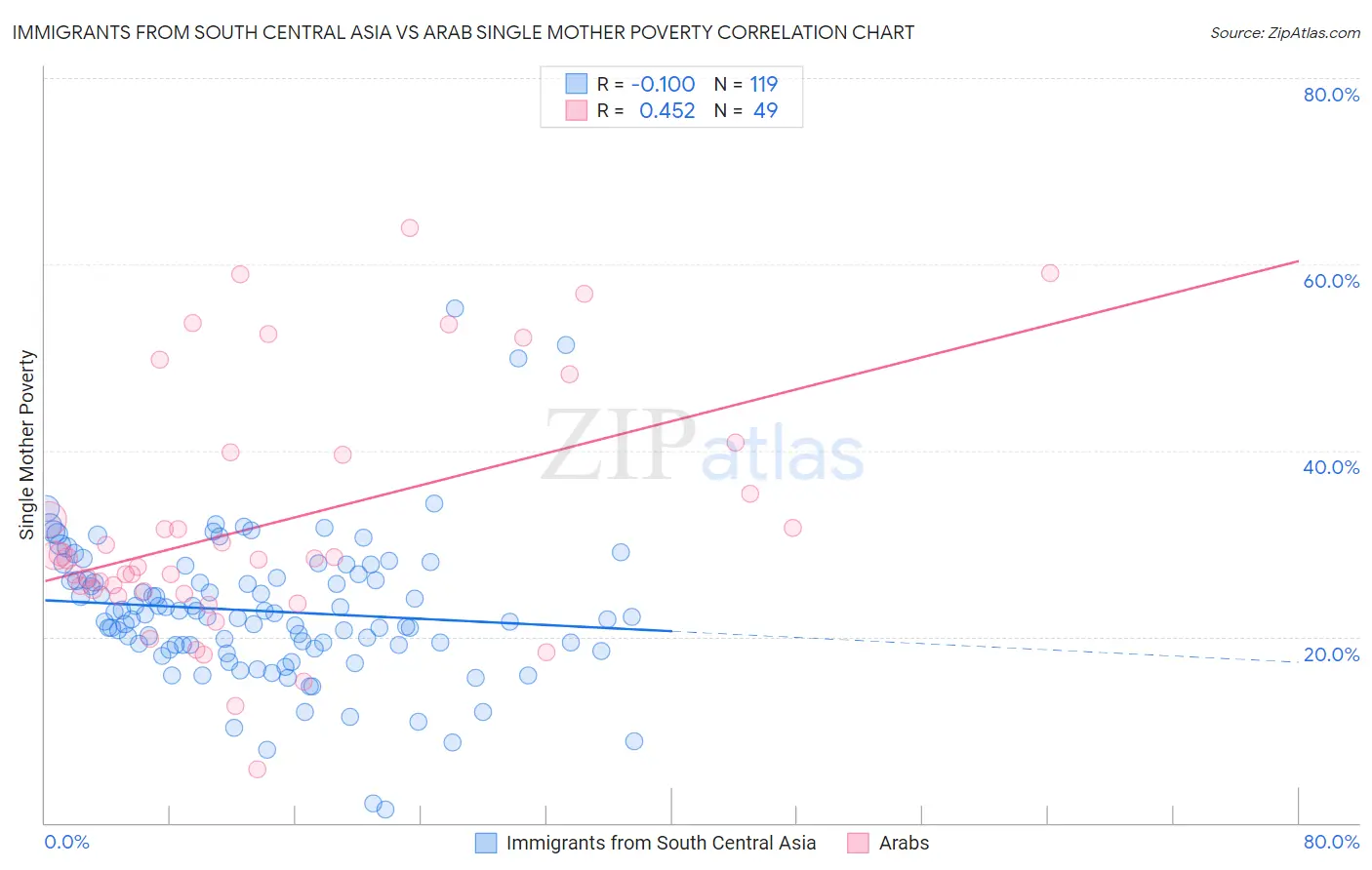Immigrants from South Central Asia vs Arab Single Mother Poverty
COMPARE
Immigrants from South Central Asia
Arab
Single Mother Poverty
Single Mother Poverty Comparison
Immigrants from South Central Asia
Arabs
25.3%
SINGLE MOTHER POVERTY
100.0/ 100
METRIC RATING
10th/ 347
METRIC RANK
29.0%
SINGLE MOTHER POVERTY
60.7/ 100
METRIC RATING
165th/ 347
METRIC RANK
Immigrants from South Central Asia vs Arab Single Mother Poverty Correlation Chart
The statistical analysis conducted on geographies consisting of 457,659,599 people shows a slight negative correlation between the proportion of Immigrants from South Central Asia and poverty level among single mothers in the United States with a correlation coefficient (R) of -0.100 and weighted average of 25.3%. Similarly, the statistical analysis conducted on geographies consisting of 470,668,307 people shows a moderate positive correlation between the proportion of Arabs and poverty level among single mothers in the United States with a correlation coefficient (R) of 0.452 and weighted average of 29.0%, a difference of 14.9%.

Single Mother Poverty Correlation Summary
| Measurement | Immigrants from South Central Asia | Arab |
| Minimum | 1.4% | 5.8% |
| Maximum | 55.3% | 63.9% |
| Range | 53.9% | 58.1% |
| Mean | 22.7% | 32.2% |
| Median | 22.2% | 28.4% |
| Interquartile 25% (IQ1) | 19.1% | 24.8% |
| Interquartile 75% (IQ3) | 26.3% | 39.7% |
| Interquartile Range (IQR) | 7.2% | 14.9% |
| Standard Deviation (Sample) | 7.9% | 13.3% |
| Standard Deviation (Population) | 7.8% | 13.2% |
Similar Demographics by Single Mother Poverty
Demographics Similar to Immigrants from South Central Asia by Single Mother Poverty
In terms of single mother poverty, the demographic groups most similar to Immigrants from South Central Asia are Immigrants from Lithuania (25.2%, a difference of 0.19%), Immigrants from Iran (25.1%, a difference of 0.60%), Iranian (25.5%, a difference of 1.1%), Bhutanese (25.6%, a difference of 1.4%), and Indian (Asian) (25.8%, a difference of 2.0%).
| Demographics | Rating | Rank | Single Mother Poverty |
| Immigrants | Taiwan | 100.0 /100 | #3 | Exceptional 23.9% |
| Filipinos | 100.0 /100 | #4 | Exceptional 24.3% |
| Immigrants | Hong Kong | 100.0 /100 | #5 | Exceptional 24.4% |
| Thais | 100.0 /100 | #6 | Exceptional 24.5% |
| Chinese | 100.0 /100 | #7 | Exceptional 24.6% |
| Immigrants | Iran | 100.0 /100 | #8 | Exceptional 25.1% |
| Immigrants | Lithuania | 100.0 /100 | #9 | Exceptional 25.2% |
| Immigrants | South Central Asia | 100.0 /100 | #10 | Exceptional 25.3% |
| Iranians | 100.0 /100 | #11 | Exceptional 25.5% |
| Bhutanese | 100.0 /100 | #12 | Exceptional 25.6% |
| Indians (Asian) | 100.0 /100 | #13 | Exceptional 25.8% |
| Immigrants | Singapore | 100.0 /100 | #14 | Exceptional 25.8% |
| Immigrants | Ireland | 100.0 /100 | #15 | Exceptional 25.8% |
| Bolivians | 100.0 /100 | #16 | Exceptional 25.9% |
| Asians | 100.0 /100 | #17 | Exceptional 26.0% |
Demographics Similar to Arabs by Single Mother Poverty
In terms of single mother poverty, the demographic groups most similar to Arabs are Inupiat (29.0%, a difference of 0.020%), Costa Rican (29.0%, a difference of 0.12%), European (29.1%, a difference of 0.16%), Immigrants from Uruguay (29.1%, a difference of 0.17%), and Immigrants from Nigeria (28.9%, a difference of 0.27%).
| Demographics | Rating | Rank | Single Mother Poverty |
| Immigrants | Hungary | 70.6 /100 | #158 | Good 28.9% |
| Czechs | 68.4 /100 | #159 | Good 28.9% |
| Japanese | 68.0 /100 | #160 | Good 28.9% |
| Immigrants | Cambodia | 66.6 /100 | #161 | Good 28.9% |
| Scandinavians | 66.2 /100 | #162 | Good 28.9% |
| Immigrants | Nigeria | 65.9 /100 | #163 | Good 28.9% |
| Immigrants | Kenya | 65.9 /100 | #164 | Good 28.9% |
| Arabs | 60.7 /100 | #165 | Good 29.0% |
| Inupiat | 60.4 /100 | #166 | Good 29.0% |
| Costa Ricans | 58.4 /100 | #167 | Average 29.0% |
| Europeans | 57.6 /100 | #168 | Average 29.1% |
| Immigrants | Uruguay | 57.2 /100 | #169 | Average 29.1% |
| New Zealanders | 55.1 /100 | #170 | Average 29.1% |
| Puget Sound Salish | 55.1 /100 | #171 | Average 29.1% |
| Carpatho Rusyns | 53.8 /100 | #172 | Average 29.1% |